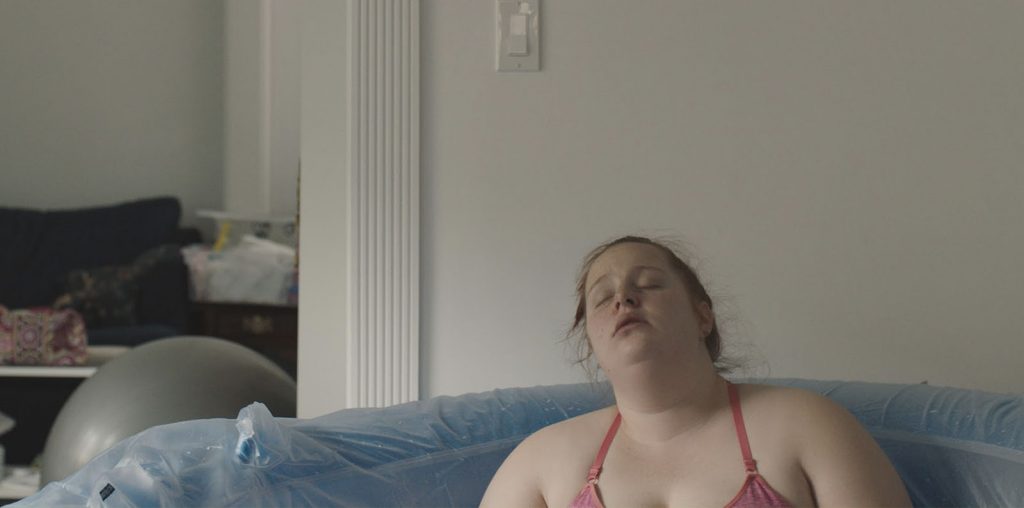
This documentary portrait of a 24 year old Filipino-American man named Michael, living in suburban California, mixes vérité footage with still photos and voice-over interviews. The film opens with Michael, lying around in bed with his girlfriend. The girlfriend is an unpleasant young woman, who laughs when telling the story of how her young nephew almost choked to death. The title “Pumkin Little” refers to the name of her stuffed animal toy, and, by extension, to the ambivalence which their generation feels towards becoming adults. This footage has a startling intimacy, because the two young people act as if they have forgotten that they are being filmed. It does make you wonder why exactly the two of them enjoy having their most intimate moments videotaped. (Answer, like so many other things in their lives: it just seems to be an interesting thing to do.)
The photos reveal the extremely comfortable surroundings in which Michael lives: a spacious, well-furnished house with pool, musical instruments, and all the comforts one could desire. We also see his collection of Catholic icons. It is implied that Michael still lives with his parents, since at one point he says that his room is converted from the garage where he practiced breakdancing in high school, but this is not clarified. In fact, his parents are curiously absent from the film and from almost all of the stories Michael tells. (For one brief second, you can see his mother reflected in a window.)
A lot of footage in the center of this film presents Michael and the crew that he breakdances with. He began dancing in high school, and returned to it in college. In the voice-over interview, he describes how breakdancing formed a core in his life which helped him through the difficult process of growing up. It is remarkable how the breakdancing crew forms a true community and alternative family. They encourage each other to take physical risks, but in a supportive and intelligent way. It is a completely collaborative artform, with the choreography created collectively. Michael tells the story of how, in high school, he almost got into real trouble with drugs and gangs. The dancing apparently was a key element which helped him stay out of serious trouble. The film shows what a remarkable cultural invention breakdancing is. (Interestingly, African-Americans, whose culture is being appropriated here, are absent from the film. Is this because they are also absent from this suburb, or because none of these young Asian people hang out with them?)
Breakdancing, among other things, is a form of dance so convincingly macho that it makes boys happy to describe themselves as “dancers,” yet it is a movement form with considerable grace and elegance. (Only one girl is seen dancing in the film.) I’m reminded of Jean Genet’s prescient observation (in his 1958 play “The Blacks” which predates graffiti and breakdancing by a long way) that African-Americans would some day “invent a criminal painting and dancing.” These Asian-American boys, like many other immigrants, find that African-American culture provides the perfect way to accomplish the twin goals of being “more American” and also being “cool.”
The film also contains a series of interviews (in voice-over) with various twenty-somethings, who are asked to reminisce about the 8th grade. Predictably, most of the stories center on traumatic incidents of being embarrassed in front of their peers. These interviews aren’t especially insightful, funny, interesting, or illuminating of Michael’s story, and the film would be stronger without them.
Even though outwardly, Michael’s life is very focused and he has accomplished many things, his life has a strangely aimless quality. He dabbles in music, sports, breakdancing, video games, cars, and other pastimes, but doesn’t develop a passion for any of them. He comes closest to being passionate about the dancing, because of the strong sense of community, but he is constantly thinking of giving it up, since it is obviously not an appropriate activity for an adult. Although he has obtained his undergraduate degree in psychology and is applying to graduate school, he is not passionate about doing any particular kind of work or affecting the world in any way. 24 is pretty old for a person to have no sense of what they’re doing in the world.
Motlagh has set himself an extremely difficult artistic task: to present a cinematic portrait of young people in suburbia whose lives are characterized by aimlessness, uncenterdness, and emptiness . (Many filmmakers have become interested in this challenge, especially in the post-Columbine era.) The problem is how to express and explore these qualities without making a film which itself is wandery, aimless and superficial. Motlagh and Green’s musical score for guitars has the same noodling, wandery, unfocused quality as the lives of the young people in the film, and thus it does recreate the texture of their lives, but, at the same time, the music makes the film feel like it’s going nowhere. The voice-over interviews are problematic, because Michael and the other characters are not particularly insightful or articulate about their own lives. The vérité footage is the most successful, because it allows the viewer to experience the characters lives directly.
The film doesn’t attempt to probe deeply into what is inside of all of this alienation. (Usually what one finds inside American alienation is rage, which is hard to uncover, and depression, which is hard to dramatize.)
“Pumkin Little” is an intriguing glimpse into the lives of young, affluent Asian-Americans, but the film has an unfortunate tendency to share in their alienated aimlessness, rather than expressing and exploring it in depth.

